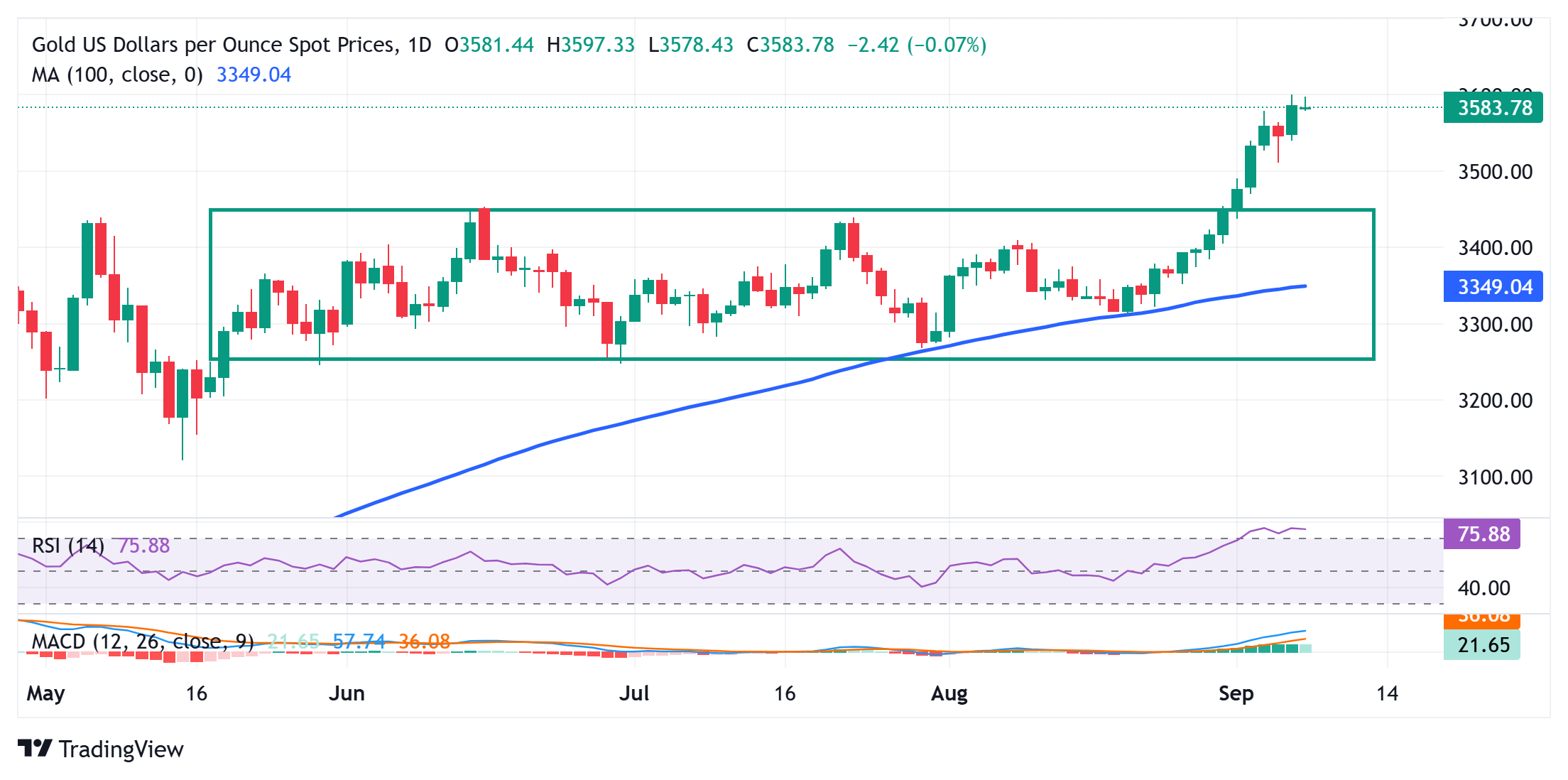Gold consolidates near record high as USD recovery and positive risk tone weigh

- Gold is seen consolidating last week’s strong record-setting bullish run.
- A modest USD uptick and a positive risk tone cap the upside for the commodity.
- Fed rate cut bets could limit the USD gains and support the non-yielding metal.
Gold (XAU/USD) enters a bullish consolidation phase at the start of a new week and oscillates in a range just below the $3,600 mark, or the all-time peak touched on Friday. A modest US Dollar (USD) bounce from its lowest level since July 28 set on Friday, in reaction to the disappointing release of the US monthly jobs report, turns out to be a key factor acting as a headwind for the commodity. Apart from this, a generally positive tone around the equity markets contributes to capping the upside for the safe-haven precious metal.
Any meaningful USD appreciation, however, seems elusive in the wake of rising bets for a more aggressive policy easing by the Federal Reserve (Fed), bolstered by weaker-than-expected US employment details. Furthermore, central banks continue to be net buyers of the commodity even in the current price range. This, in turn, might continue to offer support to the non-yielding Gold. However, overbought conditions might hold back the XAU/USD bulls from placing fresh bets ahead of the latest US inflation figures later this week.
Daily Digest Market Movers: Gold bulls pause for a breather amid modest USD uptick, receding safe-haven demand
- The US Nonfarm Payrolls report released on Friday showed that the economy added just 22,000 jobs in August, missing market expectations by a big margin. Moreover, revisions to earlier prints revealed the economy lost 13K jobs in June, marking the first monthly decline since December 2020 and pointing to deteriorating US labor market conditions.
- Additional details revealed that the US Unemployment Rate edged higher to 4.3% from 4.2% in July, as anticipated, while the Labor Force Participation Rate ticked up to 62.3% from 62.2%. Finally, annual wage inflation, as measured by the change in the Average Hourly Earnings, declined to the 3.7% YoY rate in August from 3.9% in the previous month.
- Traders were quick to react and are now pricing in a small possibility of a jumbo rate cut by the Federal Reserve in September. Moreover, market participants see a greater chance that the US central bank might lower borrowing costs three times by the end of this year, which, in turn, pushed the Gold price to the $3,600 mark, or a fresh all-time high on Friday.
- The US Dollar kicks off the new week on a positive note and recovers a part of the post-NFP slump to over a one-month low. Adding to this, the upbeat market mood acts as a headwind for he safe-haven precious metal at the start of a new week. Traders now look to the release of the latest US inflation figures due later this week for a fresh impetus.
Gold needs to consolidate before the next leg up amid overbought RSI on the daily chart

The Relative Strength Index (RSI) is holding well above the 70 mark on the daily chart and points to overbought conditions. This makes it prudent to wait for some near-term consolidation or a modest pullback before the XAU/USD bulls start positioning for an extension of the recent breakout momentum through a multi-week-old trading range.
Any corrective decline, however, is more likely to attract fresh buyers near the $3,545 region. This should help limit the downside near the $3,510-3,500 region. A convincing break below the latter, however, could drag the Gold price to the trading range resistance breakpoint, around the $3,440 region, which should act as a strong near-term base.
Gold FAQs
Why do people invest in Gold?
Gold has played a key role in human’s history as it has been widely used as a store of value and medium of exchange. Currently, apart from its shine and usage for jewelry, the precious metal is widely seen as a safe-haven asset, meaning that it is considered a good investment during turbulent times. Gold is also widely seen as a hedge against inflation and against depreciating currencies as it doesn’t rely on any specific issuer or government.
Who buys the most Gold?
Central banks are the biggest Gold holders. In their aim to support their currencies in turbulent times, central banks tend to diversify their reserves and buy Gold to improve the perceived strength of the economy and the currency. High Gold reserves can be a source of trust for a country’s solvency. Central banks added 1,136 tonnes of Gold worth around $70 billion to their reserves in 2022, according to data from the World Gold Council. This is the highest yearly purchase since records began. Central banks from emerging economies such as China, India and Turkey are quickly increasing their Gold reserves.
How is Gold correlated with other assets?
Gold has an inverse correlation with the US Dollar and US Treasuries, which are both major reserve and safe-haven assets. When the Dollar depreciates, Gold tends to rise, enabling investors and central banks to diversify their assets in turbulent times. Gold is also inversely correlated with risk assets. A rally in the stock market tends to weaken Gold price, while sell-offs in riskier markets tend to favor the precious metal.
What does the price of Gold depend on?
The price can move due to a wide range of factors. Geopolitical instability or fears of a deep recession can quickly make Gold price escalate due to its safe-haven status. As a yield-less asset, Gold tends to rise with lower interest rates, while higher cost of money usually weighs down on the yellow metal. Still, most moves depend on how the US Dollar (USD) behaves as the asset is priced in dollars (XAU/USD). A strong Dollar tends to keep the price of Gold controlled, whereas a weaker Dollar is likely to push Gold prices up.







